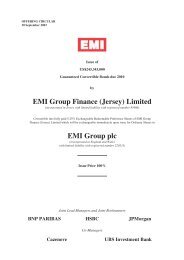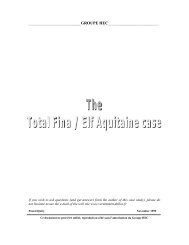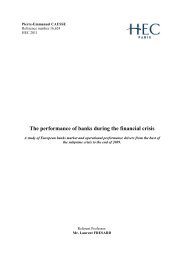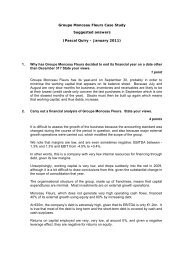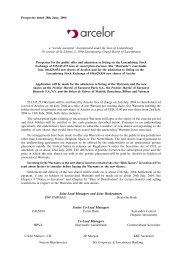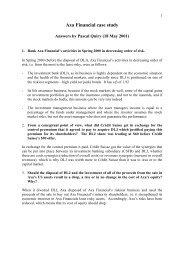Thesis_gd_final_vers.. - Vernimmen
Thesis_gd_final_vers.. - Vernimmen
Thesis_gd_final_vers.. - Vernimmen
You also want an ePaper? Increase the reach of your titles
YUMPU automatically turns print PDFs into web optimized ePapers that Google loves.
growth rates, which cannot be explained by the development of new businesses as both the asset<br />
mix and the revenue mix are staying relatively constant overtime. Consequently the growth comes<br />
from existing activities and especially lending. This strongly growing lending activity may be a hint<br />
of the riskier profile of failed banks. Indeed, a very strong growth in loans issuance can conduct to<br />
less careful applicant screening, to lowering credit standards, thus favouring lending volume over<br />
risk and quality. Moreover lending expansion into new geography or previously un-addressed<br />
riskier customer segments in which the bank did not have any informational advantage may have<br />
resulted in the bank attracting marginally riskier borrowers, which then increased the risks on the<br />
balance sheet. The fact that failed banks were holding riskier loans and were having borrowers of<br />
lower credit quality is reflected by the strong rise of the level of non-performing loans when the<br />
crisis starts. As a consequence, failed banks were much more severely hit by the crisis because of<br />
their riskier assets. Losses on their loan portfolios brought them progressively to financial distress<br />
and then to bankruptcy. Concerning the financing, failed banks have been exposed to higher<br />
liquidity risk because they relied more on non-core funding sources such as brokered deposits,<br />
alternative funding and to a lesser extent federal funds. This riskier financing structure may be a<br />
direct consequence of the strong growth of their total assets. Because it is difficult to increase<br />
rapidly core deposits or equity, fast growing banks favour non-core funding.<br />
5) Developing a new bank failure prediction model<br />
a) Methodology<br />
We use a dynamic logistic regression using our data panel to assess the importance of our different<br />
variables in explaining bankruptcy. Shumway (2001) who was among the first to apply a dynamic<br />
model to corporate bankruptcy prediction develops a mathematical demonstration proving that<br />
one-period logit model are giving inconsistent variable coefficients and that they have a poor<br />
prediction ability compared to dynamic logistic regression. To our knowledge, dynamic models<br />
have been only applied to predict bank failures by Cole and Wu (2009), who demonstrate the<br />
superior in-sample as well as out of sample prediction accuracy of a dynamic logistic regression.<br />
Cole and Wu (2009) use data from Call Reports between 1980 and 1992, that they divide into two<br />
intervals 1980-1989 which is their sample period, and 1989-1992 which is used for the out of<br />
sample prediction. They compare the results of the logistic regression with the results of a probit<br />
model using the same variables. They find that a dynamic logistic regression yields much more<br />
accurate results than the one-period probit model. They also develop a second dynamic logistic<br />
regression model adding to the accounting variables from the Call Reports variables which are<br />
linked to economic data such as interest rate and GDP evolution, but they do not find that the<br />
- 44 -



